Native People

For some 2,500 years, the Serrano (Spanish
for “mountain people”) Indians occupied
Yahaviat (pine place) on the northern and
southern faces of the San Bernardino
Mountains, as far north as the flat desert
bounded by the Tehachapi Mountains.
In this land of plenty, the Serrano hunted
large and small game with bows and arrows,
throwing sticks, traps, nets and snares. They
supplemented their diet with acorns, piñon
nuts, various berries, roots, seeds and tubers.
Alongside rivers and streams, the Serrano
people lived in small settlements of 10 to 20
dwellings. Their circular-shaped homes were
usually of willow frames covered in brush
or tule reeds and tied with various fibers
or rawhide. Several of these settlements,
including Yucaipa and Cucamonga, are
recalled today by modern towns that bear
their names. Trade with the Mojave people
to the east and the Gabrielino to the west
brought the Serrano goods and, later, horses.
The Serrano used ritual, including songs
and storytelling, to pass on the knowledge
necessary to maintain the earth’s natural
order. Skilled artisans, the Serrano were
known for their delicate, ornate pottery and
woven baskets.
The stable lives and traditions
of the Serrano changed
drastically around 1790, when
they were drawn into the
San Gabriel Mission. Hard
labor and European diseases took their toll. By the early 20th century, a group of approximately 1,500
Serrano people had dwindled to 119. Today some Serrano descendents live on or near the San Manuel and Morongo
Reservations.
Serrano Ethnography & Ethno History
Traditional Territory, Oral History, Resources, Material Culture, Technology, Trade/Exchange, Religion, History ...Additional Indian cultural information:
California Desert Indian Uses of Native Plants
In the desert, Indians found native plants and other natural objects that not only ensured their survival but also ...For historical information on California Indian cultures see: